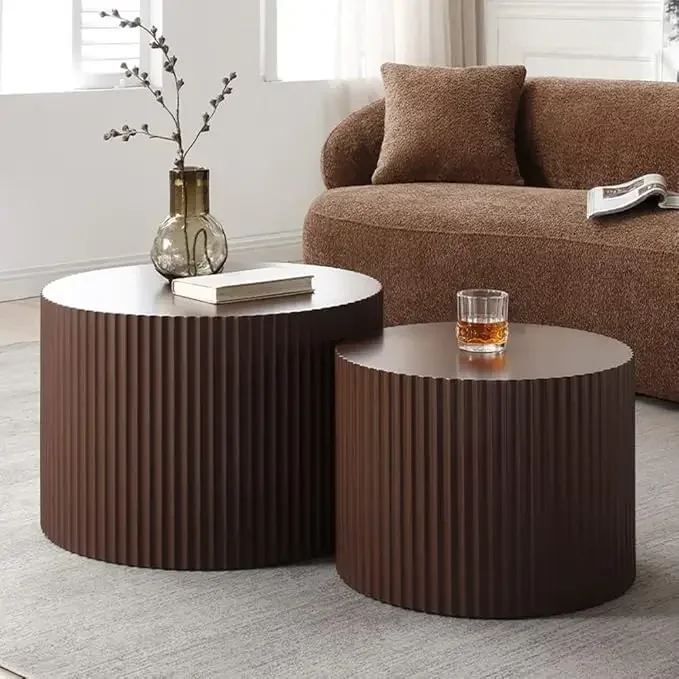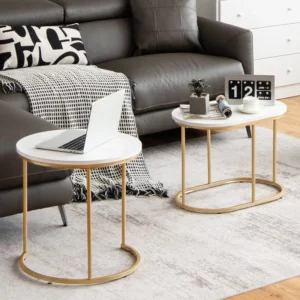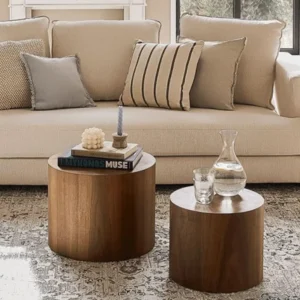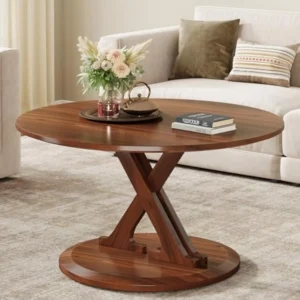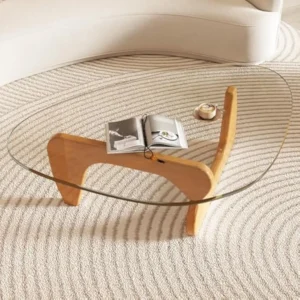Understanding the Appeal: Why Round Coffee Tables Transform Open Layouts
When it comes to furnishing an open floor plan, every piece plays a crucial role in defining the space while maintaining its inherent openness. Round coffee tables stand out as particularly effective choices for these expansive layouts, offering advantages that go beyond mere aesthetics.
The magic of round coffee tables in open concepts begins with their smooth, continuous shape. Unlike rectangular or square tables with defined corners, round tables create visual continuity that complements the flowing nature of open spaces. This seamless design allows the eye to travel uninterrupted around the room, enhancing the sense of spaciousness that makes open floor plans so desirable.
Movement patterns benefit tremendously from circular designs. In open layouts where people frequently walk between kitchen, dining, and living areas, round tables eliminate the hazard of sharp corners that interrupt natural pathways. This subtle but significant feature makes a substantial difference in how comfortably people navigate the space.
Round coffee tables also excel at creating natural gathering spots in open floor plans. Their shape inherently:
- Encourages equal interaction among everyone seated around them
- Eliminates hierarchy that comes with rectangular tables (no “head” of the table)
- Allows for easier conversation flow between all participants
- Creates a democratic seating arrangement that feels more inclusive
From a psychological perspective, curved furniture like round coffee tables tends to evoke feelings of comfort and relaxation. Research in environmental psychology suggests that humans respond more positively to curved rather than angular shapes in their surroundings. This makes round tables particularly suited to open living spaces designed for comfort and connection.
The versatility of intelligent black mid-century coffee tables demonstrates how these principles have been refined over decades of design evolution. When comparing round tables to their rectangular counterparts in open layouts, the difference becomes clear: rectangular tables create visual stops where the eye halts at corners, while round tables guide vision in a continuous, flowing manner.
For those considering different options, browsing through quality mid-century modern round coffee tables offers excellent examples of how these principles manifest in various designs and materials.
The Fluidity Factor: How Curves Enhance Flow and Movement
The fluid nature of round coffee tables creates a remarkable impact on how we experience open floor plans. Without sharp corners interrupting the space, both visual and physical movement flows more naturally throughout the area. This becomes especially apparent in the transition zones between functional areas in an open concept—such as moving from the kitchen to the living area.
Round edges act as visual guides rather than barriers, subtly directing traffic around rather than forcing abrupt turns. This creates invisible pathways that feel intuitive and unforced. In busy households where multiple people navigate these spaces simultaneously, this improved flow reduces congestion points that typically form around furniture with corners.
The graceful curves of round tables also complement other design elements typically found in open spaces. From arched doorways to curved kitchen islands, these tables create a visual rhythm that ties different areas together while maintaining their distinct functions. Many interior designers recognize how oval coffee tables enhance room flow in similar ways, providing options for spaces that might benefit from a slightly elongated yet still curved form.
Space Illusion: Making Your Open Concept Feel Even More Expansive
One of the most compelling benefits of round coffee tables is their ability to create the illusion of even more space in already open floor plans. This happens through several visual mechanisms that we often perceive subconsciously.
First, round tables eliminate the “dead corners” that rectangular tables create—those awkward spaces that serve no practical purpose but visually consume square footage. With a round table, every inch of the footprint is usable and visually accessible.
Second, the continuous curve of a round table draws the eye in a sweeping motion rather than stopping abruptly at corners. This creates a sense of movement and expansion rather than limitation. Even when two tables occupy exactly the same square footage, the round one will typically make the space feel more open.
Consider this comparison: a 36-inch square table occupies 9 square feet with four distinct corners. A 42-inch diameter round table occupies roughly the same area but creates a visually lighter impression because the eye follows its continuous curve without interruption.
This visual lightness becomes particularly valuable in open floor plans where maintaining spaciousness is a priority. The absence of corners means fewer visual barriers, contributing to the expansive feeling that makes open concepts so appealing.
The Social Hub: Fostering Conversation and Connection
Round coffee tables naturally encourage more inclusive social interactions—a perfect match for open floor plans designed for connectivity and togetherness. Their circular shape inherently promotes equality in conversation, as no person sits at a head position or corner that might feel separated from the group.
Imagine a typical gathering scenario: friends and family naturally arrange themselves in a circle around a round coffee table, all facing each other with equal distance and visibility. Compare this to rectangular tables where people at opposite ends might need to lean forward or raise their voices to engage with one another.
This democratic seating arrangement supports the very essence of open floor plans—spaces designed to bring people together rather than compartmentalize them. Research in social dynamics has consistently shown that circular arrangements foster more equal participation in discussions and create a greater sense of community.
In family homes with open layouts, this becomes particularly valuable for game nights, casual meals, or simply gathering for conversation—activities where equal participation enhances the experience for everyone involved.
Safety First: The Kid and Pet-Friendly Advantage
Open floor plans often serve as the heart of family life, making safety considerations paramount when selecting furniture. Round coffee tables offer significant advantages in this regard that particularly benefit households with young children and pets.
The safety benefits of round coffee tables include:
- No sharp corners that can cause injuries when children run or fall
- Smoother edges that reduce impact severity if collisions occur
- Lower risk of scratches and bruises from accidental bumps
- Fewer protrusions that pets might collide with when playing
- Reduced chance of clothing snagging on corners
These safety features become especially valuable in open floor plans where children have more room to run and play. The continuous play area that open concepts provide is complemented by furniture that minimizes hazards while maintaining style and function.
For families specifically looking for child-friendly options, exploring round mid-century coffee tables for family homes can provide specific designs that balance safety with sophisticated aesthetics.
Choosing Your Ideal Round Coffee Table for an Open Floor Plan
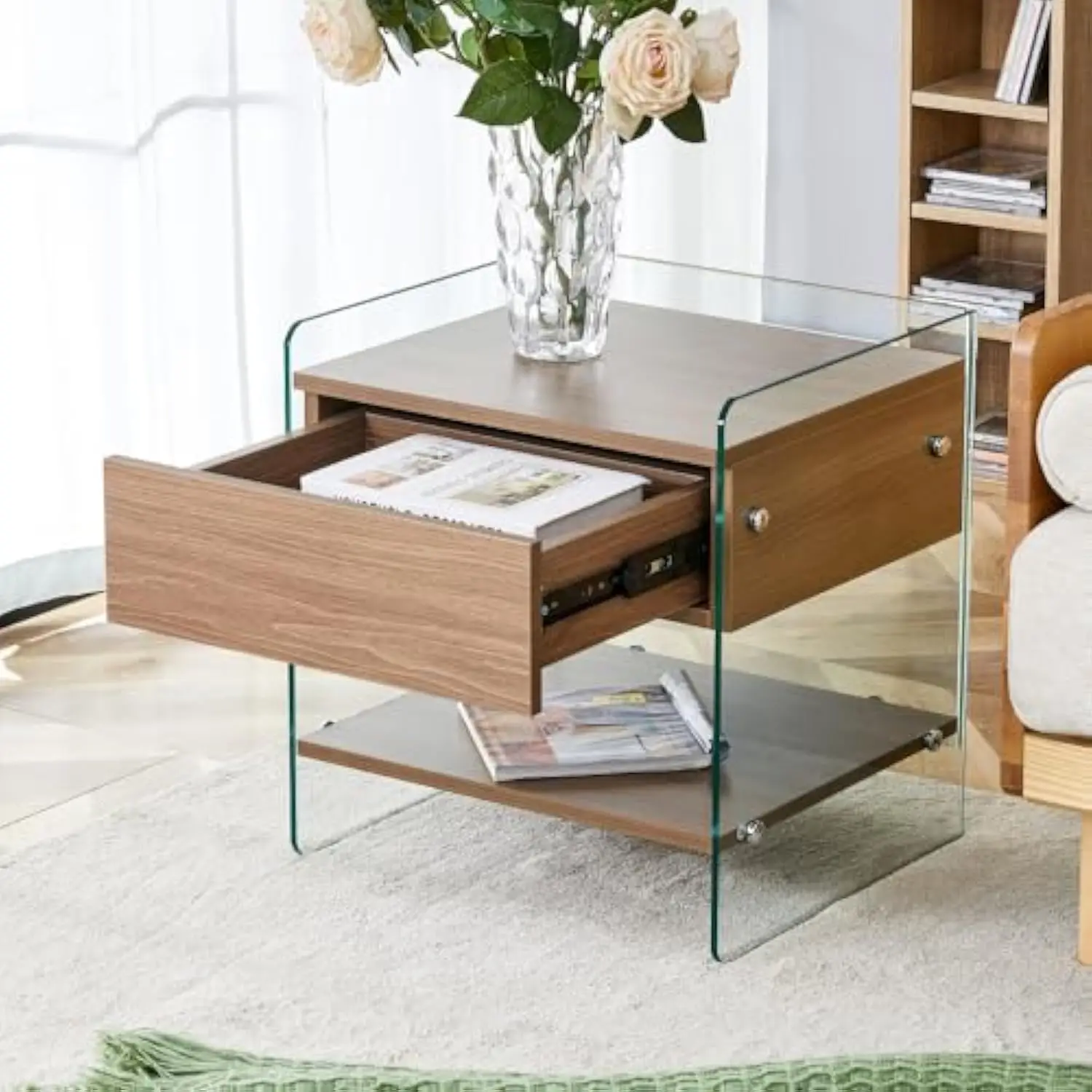
Selecting the perfect round coffee table for your open floor plan requires balancing several key factors. While the general benefits of round tables apply broadly, finding the ideal match for your specific space demands attention to size, material choice, and functionality features.
Unlike furniture selection for traditional compartmentalized rooms, open floor plans require considering how each piece affects the entire space. A coffee table that might look proportional in isolation could overwhelm an open concept when viewed as part of the whole arrangement. Conversely, a table that seems too small in a showroom might provide just the right visual weight in a spacious open layout.
The interplay between aesthetics and practicality becomes particularly important in open floor plans where the coffee table remains visible from multiple angles and areas. Your selection should complement adjacent kitchen and dining areas while still fulfilling its primary function in the living zone.
In the following sections, we’ll explore the specific considerations that will guide you toward finding a round coffee table that enhances your open floor plan’s functionality, visual appeal, and overall livability.
Sizing it Right: Proportions and Clearance for Seamless Integration
Finding the perfect size for your round coffee table is crucial for maintaining the balance and flow of your open floor plan. The widely recommended Two-Thirds Rule suggests that your coffee table should be approximately two-thirds the length of your sofa for visual harmony. For round tables, this translates to a diameter that’s about two-thirds the sofa length.
Proper clearance around your table ensures comfortable navigation and usability. Allow 12-18 inches (30-45 cm) between the table and seating to provide easy access while keeping the table within comfortable reach. For walkways around the table, maintain at least 3 feet (90 cm) of space to preserve the open floor plan’s flow.
Height alignment with your seating is equally important. The standard height range for coffee tables is 16-18 inches (40-45 cm), ideally sitting at or slightly below your sofa’s seat cushions for comfortable use without awkward reaching.
For specific room sizes, consider these diameter guidelines:
– Small open plans: 30-36 inches (75-90 cm) diameter
– Medium open plans: 36-48 inches (90-120 cm) diameter
– Large open plans: 48-60+ inches (120-150+ cm) diameter
When measuring your space for a new table, follow this simple checklist:
1. Measure your sofa length and multiply by 0.66 to find ideal table diameter
2. Check clearance between table edge and seating (aim for 12-18 inches/30-45 cm)
3. Verify walkway width around all sides (minimum 36 inches/90 cm)
4. Compare table height to seating height (table should be equal to or slightly lower than seat cushions)
For apartments and smaller spaces, exploring coffee table sizes for small living rooms can provide additional guidance on maintaining proportion without sacrificing functionality.
Material Matters: Balancing Aesthetics, Durability, and Lifestyle
The material of your round coffee table significantly impacts both its visual presence and practical performance in your open floor plan. Each option brings distinct advantages worth considering against your lifestyle needs and design preferences.
Wood
Wooden tables bring natural warmth and character to open floor plans, often softening the expansiveness with their organic appeal. From oak and walnut to maple and teak, different species offer varying grain patterns, colors, and durability profiles. Wood adapts beautifully to most design styles but requires some maintenance to protect against moisture rings and scratches.
Glass
Glass-topped tables create visual lightness that helps maintain the spacious feel of open concepts. By allowing sightlines to continue through to the floor beneath, they minimize visual interruption while showcasing beautiful flooring or rugs. Modern mid-century modern glass top coffee tables combine this airy quality with distinctive bases for architectural interest. While offering easy cleaning, glass does require regular maintenance to keep fingerprints and dust at bay.
Metal
Metal frames and surfaces bring contemporary edge and exceptional durability to high-traffic open layouts. Whether in brushed steel, matte black, or warmer tones like brass or copper, metal tables provide structural strength with minimal visual bulk. Their temperature responsiveness—cool in summer and cold in winter—is worth considering if tactile comfort matters to your household.
Stone/Marble
Stone-topped tables introduce luxury and natural variation that can anchor an open space with their substantial presence. Marble, granite, or quartz surfaces create sophisticated focal points while offering excellent durability against heat and moisture. Their weight provides stability but makes rearrangement more challenging when you want to reconfigure your open space.
Mixed Materials
Combinations like wood frames with glass tops or metal bases with stone surfaces offer the benefits of multiple materials while creating visual interest. These hybrid designs often provide the ideal middle ground between purely heavy or light visual impressions, helping balance the overall feel of your open floor plan.
Upholstered Options
Fabric or leather-topped coffee tables (usually with storage inside) add unexpected softness to open layouts while providing comfortable surfaces for feet or casual seating. Their sound-absorbing properties can help address the acoustic challenges sometimes present in open floor plans.
When selecting materials, consider not just your aesthetic preferences but how the material will perform with your specific lifestyle factors—children, pets, entertainment habits, and maintenance willingness all influence which option will serve you best over time.
Functionality Features for Open Living
Beyond size and material, the functional features of your round coffee table can dramatically enhance how well it serves your open floor plan lifestyle. The right functionality transforms a simple surface into a versatile tool that supports your daily activities.
Storage solutions are particularly valuable in open concepts where maintaining visual order contributes to the overall aesthetic. Consider these functional options:
- Built-in shelves below the tabletop for books, magazines, and remotes
- Concealed drawers that keep small items organized but out of sight
- Hidden compartments that maintain the clean lines of your table while maximizing utility
- Lift-top mechanisms that create adjustable height surfaces for dining or working
For flexibility in entertaining and everyday use, mid-century modern nesting coffee tables offer exceptional adaptability. These space-efficient designs allow multiple surfaces to be deployed when needed and tucked away when not in use—perfect for open floor plans that serve many purposes throughout the day.
Weight and stability become particularly important in busy open areas where people move freely between zones. A sturdy table that remains firmly in place despite accidental bumps preserves both safety and your floor’s finish.
Multi-functional potential should be evaluated against your typical activities. Will your table occasionally need to serve as a dining surface, work area, or game table? The most successful coffee tables for open concepts adapt to these varied uses without compromise.
Integrating Your Round Coffee Table into an Open Floor Plan Design
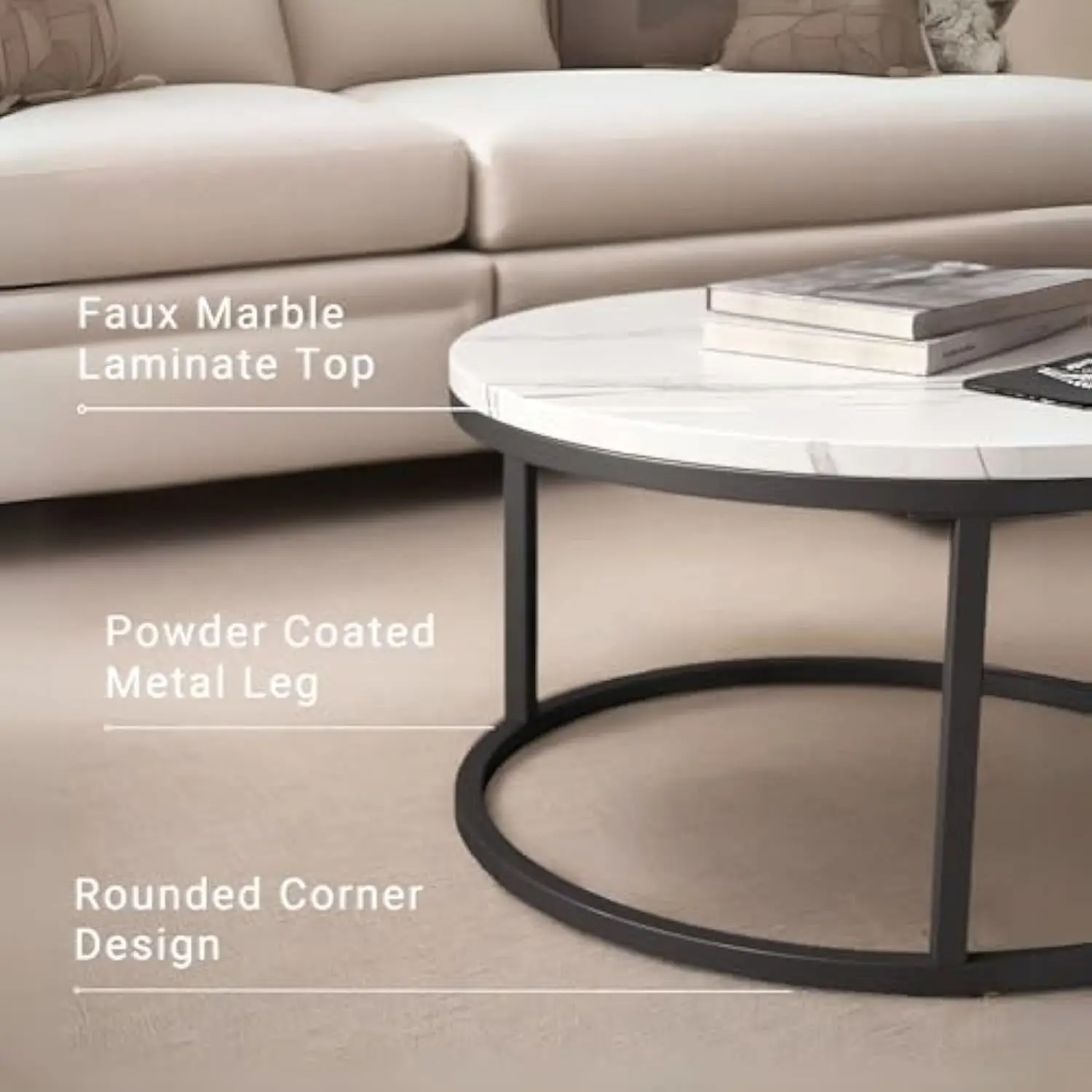
Moving beyond selection to strategic placement transforms your round coffee table from a standalone piece to an integral component of your open floor plan’s success. Professional designers approach this integration with careful consideration of both aesthetics and functionality.
Your round coffee table does double duty in an open concept—it serves as a practical surface for everyday activities while simultaneously helping define the living area within the larger space. Its placement creates visual cues about where one functional zone ends and another begins, all without interrupting the openness that makes these floor plans appealing.
Rather than viewing your table in isolation, consider its relationship to every element within sight—from kitchen fixtures to dining furniture to architectural features like fireplaces or windows. This holistic approach ensures your coffee table enhances rather than competes with the overall composition of your home.
The following sections will guide you through specific strategies for using your round coffee table as a design tool to maximize your open floor plan’s potential.
Defining Zones without Walls
A round coffee table serves as an exceptional anchoring element that helps delineate your living area within the larger open floor plan. When properly positioned, it creates a clear sense of where your conversation zone exists without resorting to physical barriers.
For optimal zone definition, center your round coffee table within your seating arrangement rather than pushing it toward one side. This central placement naturally draws attention inward, creating an invisible boundary for the living area. The circular shape radiates this zoning effect equally in all directions, unlike rectangular tables that create more linear delineations.
Pairing your coffee table with an area rug dramatically enhances this zoning effect. For proper proportion, select a rug large enough to accommodate both the table and at least the front legs of surrounding seating. The rug should extend 18-24 inches (45-60 cm) beyond your table’s edge in all directions to create a cohesive conversation area.
For additional guidance on perfecting this arrangement, exploring ideas for styling black mid-century coffee tables offers specific techniques that work particularly well in open layouts, regardless of the table color.
To strengthen zone definition without compromising openness:
– Position seating to face inward toward the table, creating a conversational circle
– Maintain consistent space between the table edge and all seating pieces
– Consider using the table as the midpoint between opposing seating elements
– Allow walkways to flow around, not through, the seating arrangement
This intentional placement creates psychological boundaries that help organize the space while preserving the open sight lines and movement patterns that make your floor plan special.
Achieving Harmony and Cohesion
Creating visual harmony across your open floor plan requires thoughtful coordination between your round coffee table and surrounding elements. Rather than strict matching, aim for complementary relationships that tie spaces together while allowing each zone its distinct character.
When selecting your coffee table, consider two approaches: matching or complementing. Matching involves choosing a table that shares distinct characteristics with other furniture, such as the same wood tone as your dining table or the same metal finish as kitchen fixtures. Complementing takes a more subtle approach, selecting elements that harmonize without direct repetition—perhaps a marble-topped table that picks up veining colors found in nearby upholstery.
Color coherence plays a crucial role in open plan harmony. Your coffee table can either continue the color story from adjacent areas or introduce a controlled contrast that creates visual interest. When using contrast, ensure the table’s color appears at least two other places within the visible space to create intentional repetition rather than random variation.
Material consistency creates immediate visual connections across zones. If your kitchen features warm woods, a wooden coffee table with similar tones creates an intuitive relationship between spaces. Alternatively, deliberate material contrasts can define zones while maintaining harmony through other shared elements like color or shape.
For homes with existing mid-century elements, understanding which styles go well with mid-century modern helps ensure your coffee table integrates seamlessly with both contemporary and classic pieces.
Working with Different Seating Configurations
Your seating arrangement and coffee table should work in partnership to create an inviting, functional living space within your open floor plan. Different seating configurations benefit from specific approaches to table placement and selection.
With sectional sofas, a round coffee table brilliantly counterbalances the angular lines, creating visual relief from the structured seating. Position the table slightly closer to the corner of the L-shape, approximately 18 inches (45 cm) from each section. This placement allows comfortable access from all seating positions while softening the sectional’s geometric form.
For L-shaped seating arrangements, whether using a sectional or separate pieces, your round table improves navigation by eliminating the hazardous corners of rectangular alternatives. The smooth curve allows for easier movement through what would otherwise be a tight turning point near the corner of the L.
When working with facing sofas or sofa-chair combinations, center your round table in the conversation area, ensuring equal distance from all seating pieces. This democratic arrangement naturally facilitates interaction by placing everyone equidistant from the shared surface.
For asymmetrical arrangements with varied seating heights and depths, a round table creates a unifying center point that ties disparate elements together. In these less structured arrangements, prioritize comfortable reach distance over strict geometric centering—ensure everyone seated can easily set down or retrieve items from the table.
Considering Focal Points
Balancing your round coffee table with existing focal points requires careful consideration of visual hierarchy within your open floor plan. The coffee table should complement rather than compete with primary focal elements like fireplaces, statement lighting, or spectacular views.
In rooms with dramatic focal points like fireplaces or large windows with views, position your coffee table to enhance rather than obstruct these features. The table should act as a visual stepping stone that draws the eye toward the main attraction rather than demanding attention for itself.
When deciding whether your table should be a statement piece or supporting element, consider the visual complexity of your space. In minimalist open concepts with few decorative elements, a distinctive table with unusual materials or bold design can serve as a captivating focal point. In visually rich environments with multiple patterns and textures, a simpler table that quietly supports the overall design prevents visual overload.
Sight lines across open floor plans demand special attention. Ensure your coffee table doesn’t block important views between areas or create visual barriers that counteract the openness of your floor plan. Lower profile tables generally preserve sight lines better than taller, more substantial designs.
For balanced placement relative to architectural features, position your round table to echo existing curves in the space, such as arched doorways or curved walls. This repetition of shapes creates subtle harmony that feels intentional and sophisticated.
Styling Your Round Coffee Table Like a Pro in an Open Space
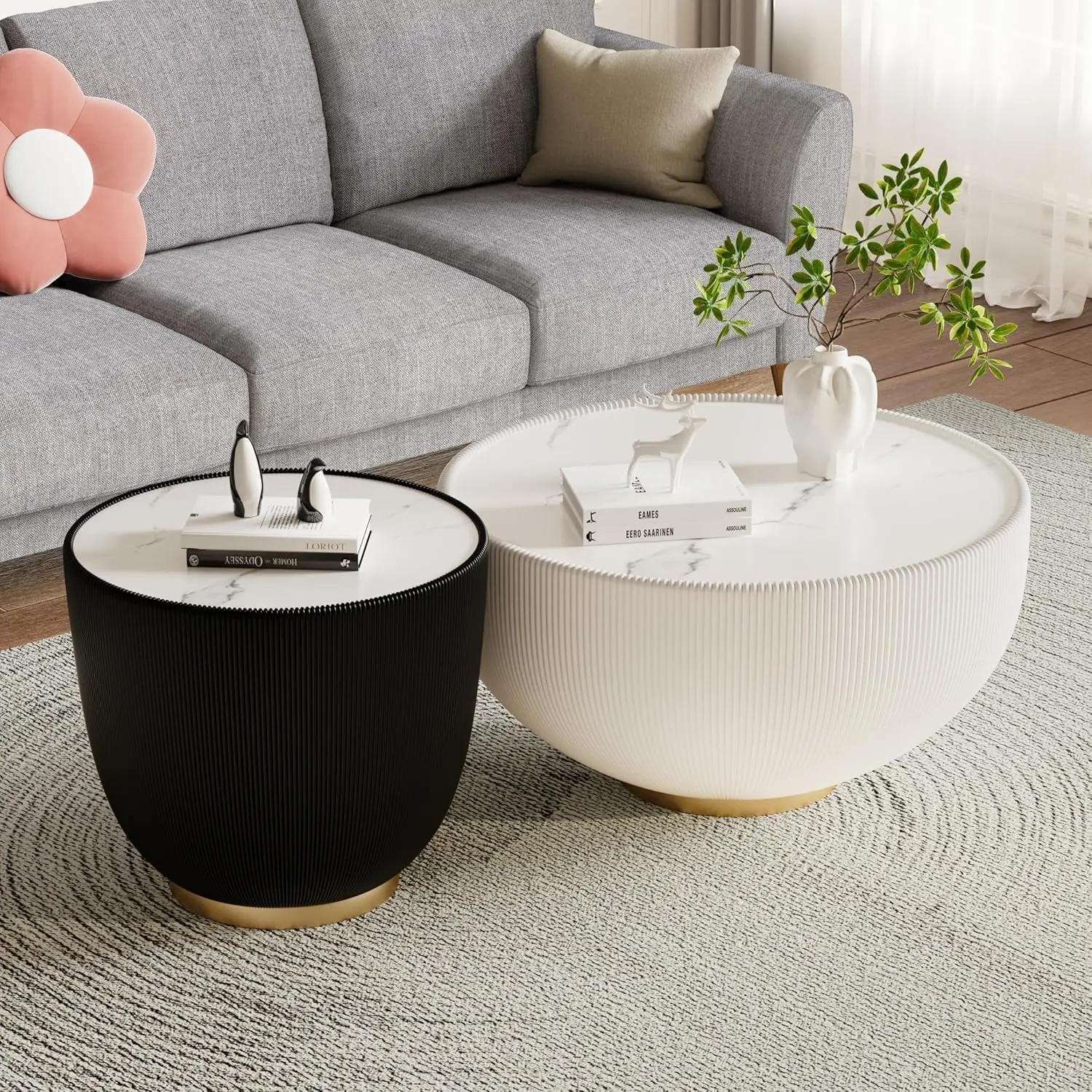
The styling of your round coffee table completes its integration into your open floor plan, transforming it from functional furniture to a design statement. In open concepts, your table styling is visible from multiple vantage points, making thoughtful decoration particularly important.
Unlike styling in traditional closed rooms, coffee table arrangements in open plans must look intentional from every angle. This 360-degree visibility means avoiding a “front” and “back” to your arrangement—each side should offer an appealing view for anyone looking toward the living area from the kitchen, dining space, or entry.
The openness also affects scale considerations. In expansive spaces, styling elements need sufficient visual weight to read well from a distance without appearing cluttered up close. Finding this balance requires attention to both the physical size of decorative items and their visual presence.
For comprehensive guidance on creating magazine-worthy arrangements, mastering round coffee table styling offers detailed approaches that work particularly well in open concept homes.
The Rule of Threes: Creating Balanced Vignettes
One of the most enduring design principles—the rule of threes—works especially well when styling round coffee tables. This approach suggests grouping decorative items in odd numbers (particularly three) to create visually interesting, asymmetrically balanced arrangements.
On a round surface, create triangular arrangements rather than linear ones. Place your tallest item slightly off-center, then position two lower items to form a rough triangle. This three-point arrangement creates natural visual movement across the circular surface, drawing the eye around the table rather than stopping it at a single point.
Balance without symmetry is the goal. Rather than placing identical items at equal distances, vary your objects’ height, width, and visual weight while maintaining an overall sense of equilibrium. This controlled imbalance creates far more visual interest than strict symmetry, particularly on round surfaces where geometric precision feels at odds with the organic shape.
For successful groupings, combine items with varying characteristics:
– One tall, one medium, one low element
– One substantial, two smaller complementary pieces
– Different textures that relate through color or material
Playing with Height and Scale
Height variation creates visual interest and dimension on your round coffee table. In open floor plans, where the table is often viewed from standing height as people move through the space, vertical elements become particularly important for catching the eye.
For standard coffee tables (16-18 inches/40-45 cm tall), limit decorative items to a maximum height of 10-12 inches (25-30 cm) to maintain clear sight lines across your open space. This height allows objects to make a visual statement without creating barriers between conversation areas.
Consider proportional relationships between your table size and decorative elements. As a general guideline:
– On small tables (30-36 inches/75-90 cm diameter): Limit the largest item to about 10 inches (25 cm) high
– On medium tables (36-48 inches/90-120 cm diameter): Items up to 12 inches (30 cm) high work well
– On large tables (48+ inches/120+ cm diameter): Taller elements up to 15 inches (38 cm) high can be appropriate
Remember that open floor plans mean your coffee table styling will be seen from all sides. Create arrangements with varying heights that look intentional from every angle, avoiding a distinct “front” or “back” to your display.
Texture and Material Mix
Incorporating diverse textures creates visual depth that makes your coffee table styling more engaging. The interplay of different surfaces catches light in varied ways, adding dimension even to monochromatic arrangements.
Combining contrasting textures—smooth with rough, matte with glossy, hard with soft—creates immediate visual interest. A smooth ceramic vase paired with a rough-hewn wooden bowl and soft fabric-bound books creates a more compelling arrangement than three items with similar finishes.
Seasonal texture variations keep your styling fresh throughout the year. Heavier, cozier textures like knit, wool, or velvet bring warmth during colder months, while lighter materials like rattan, linen, or glass feel appropriate for warmer seasons.
When selecting decorative items, consider how they complement your table’s material. On glass tables, items with interesting bases or undersides add dimension since they’re visible through the surface. Wooden tables pair beautifully with both contrasting contemporary materials and complementary natural elements.
For specific ideas on creating sophisticated texture combinations, decorating black mid-century coffee tables offers inspiration that works across various table colors and materials.
Practical Styling: Leaving Room for Living
While aesthetically pleasing arrangements are important, your coffee table must remain functional for everyday life. The most successful styling finds harmony between beauty and practicality, especially in open floor plans where the table serves multiple purposes throughout the day.
Trays are the styling workhorse of well-designed coffee tables. They corral smaller items into organized groupings while making it easy to clear space when needed—simply move the entire tray rather than multiple individual objects. Choose trays that complement your table material while contrasting slightly to avoid visual blending.
For everyday functionality, maintain clear spaces within your styling. A good rule of thumb is to leave at least one-third of your table’s surface open for practical use—setting down drinks, playing games, or displaying temporary items like fresh flowers or seasonal decorations.
Consider creating zones on your table: a decorative area with permanent styling elements and a functional area left clear or easily cleared for daily activities. This division maintains aesthetic appeal while acknowledging the table’s practical role in your home.
Mid-Century Modern Glass Top Coffee Tables, Mid-Century Modern Glass Top Side & End Tables
$460.58 Select options This product has multiple variants. The options may be chosen on the product pageMid-Century Modern Glass Top Coffee Tables, Mid-Century Modern Vintage Coffee Tables, Mid-Century Modern Vintage Side & End Tables
$725.36 Select options This product has multiple variants. The options may be chosen on the product pageMid-Century Modern Nesting Coffee Tables, Mid-Century Modern Nesting Table Sets
$361.45 Select options This product has multiple variants. The options may be chosen on the product pageMid-Century Modern Nesting Table Sets, Mid-Century Modern Round Coffee Tables
$462.57 Select options This product has multiple variants. The options may be chosen on the product pageMid-Century Modern Round Coffee Tables, Mid-Century Modern Small Coffee Tables
$452.73 Select options This product has multiple variants. The options may be chosen on the product pageMid-Century Modern Glass Top Coffee Tables
$452.73 Select options This product has multiple variants. The options may be chosen on the product page
Common Mistakes to Avoid
Even with the best intentions, certain missteps can undermine the effectiveness of your round coffee table in an open floor plan. Being aware of these common errors helps you create a more successful arrangement from the start.
Mismatched sizing occurs when selecting a table disproportionate to your space. Tables that are too large restrict movement and overwhelm the area, while undersized tables look insignificant and fail to anchor the seating arrangement properly. Always measure your space and apply the two-thirds rule before purchasing.
Traffic flow miscalculations happen when tables are positioned without considering how people naturally move through the space. This results in awkward navigation, frequent bumping into the table, or people taking unnatural paths around furniture. Always leave at least 36 inches (90 cm) of clearance for main walkways.
Style disconnection creates visual discord when the coffee table exists in isolation from the rest of your open plan’s design language. This often manifests as conflicting wood tones, mismatched design eras, or competing metal finishes that make the table feel like an afterthought rather than an integral part of the design.
Over-styling transforms the table from functional furniture to unusable display, defeating its primary purpose. When decorative elements cover more than two-thirds of the surface or create barriers between people seated around the table, practicality suffers. Remember that negative space is an essential part of good design.
Height misalignment between your table and seating creates ergonomic discomfort. Tables significantly higher or lower than your sofa seat height (typically 17-19 inches/43-48 cm) make reaching for items awkward and disrupt the visual balance of your furniture grouping.
By avoiding these common pitfalls, your round coffee table can fulfill both its aesthetic and functional potential in your open floor plan.
FAQs: Your Round Coffee Table Questions Answered
How can I determine if a round table is right for my specific open floor plan?
Assess your traffic patterns—if people frequently walk through (not just around) your living area, a round table eliminates dangerous corners. Also consider your seating arrangement; round tables work especially well with sectionals and irregularly arranged seating. Finally, if your space feels dominated by straight lines and angles, a round table can provide welcome visual relief.
What’s the best way to clean and maintain my glass-top round coffee table in a busy open floor plan?
For daily cleaning, use a microfiber cloth with a small amount of glass cleaner sprayed onto the cloth (not directly on the glass) to prevent dripping onto the base. Weekly, use a quality glass cleaner and newspaper for streak-free results. Prevent scratches by using coasters and placemats, and consider applying a thin layer of car wax twice yearly to create an invisible protective barrier that repels dust and fingerprints.
Can a round coffee table work with my large sectional sofa?
Absolutely! Round tables are actually ideal companions for sectionals because they counterbalance the angular lines and create easier navigation around the corner of the L-shape. For proper scale with large sectionals, choose a table at least 36 inches (90 cm) in diameter, positioning it slightly closer to the corner of the sectional while ensuring all seated positions have easy access.
My open floor plan is quite small. Will a round coffee table take up too much space?
Round tables can actually be space-savers in small open plans because their absence of corners allows for smoother movement around them. Consider mid-century modern small coffee tables with diameters between 30-36 inches (75-90 cm), particularly those with glass tops or slender legs that maintain visual lightness. Nesting tables offer excellent flexibility, allowing you to expand surface area when needed while storing compactly.
How much should I expect to invest in a quality round coffee table for my open floor plan?
Quality round coffee tables vary widely in price depending on materials and craftsmanship. Solid wood or genuine marble tables typically start around $300-$500 and can exceed $2,000 for designer pieces. Well-crafted glass and metal tables generally range from $200-$800. Consider this an investment piece—quality construction ensures longevity, and timeless design will serve you through multiple home arrangements.
How can I style my round coffee table to complement my mid-century modern aesthetic?
For mid-century cohesion, incorporate objects with clean lines and organic shapes. Group a low, horizontal vintage art book with a small sculptural piece in wood or ceramic and a simple brass object. Maintain plenty of negative space between items, as mid-century design embraces minimalism and breathing room. Stick to a limited color palette drawn from your existing mid-century pieces for visual continuity.
How to Choose a Round Coffee Table That Enhances Your Open Floor Plan
Selecting the perfect round coffee table for your open floor plan comes down to understanding how this central piece influences your entire living experience. The right table does more than fill space—it improves flow, enhances social interaction, provides practical functionality, and ties together your overall design vision.
Remember that open floor plans benefit tremendously from the soft, continuous lines of round tables. Their absence of corners creates smoother physical movement throughout the space while their circular form guides visual flow in a way that feels natural and unforced. The social benefits of equal interaction and safer navigation further enhance the communal nature that makes open concepts so popular.
As you consider different options, focus on finding the sweet spot between size, material, and functionality that matches your specific lifestyle. A young family might prioritize resilient materials and rounded safety, while design enthusiasts might seek statement pieces that serve as conversation starters. The beauty of round coffee tables is their adaptability to these varied needs while consistently supporting the openness that defines your floor plan.
Ultimately, your coffee table should feel like a natural extension of your living space—enhancing both its beauty and utility without drawing attention to itself as an awkward addition. When properly selected and placed, it becomes an essential element in creating a cohesive, flowing environment where life unfolds comfortably around its inviting circular form.

